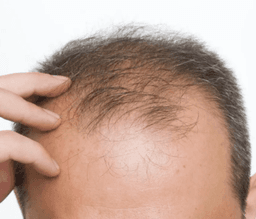Starting to lose your hair? There’s help available: you don’t have to sit back and let it happen.
One of the main hair loss treatments in the UK is finasteride. It's licensed to treat male pattern baldness (also called androgenetic alopecia or hereditary hair loss). So, how does it work? Does finasteride regrow your hair or stop you from losing more? It does both. Here's the lowdown.
Key Takeaways
- Finasteride can both prevent hair loss and encourage regrowth
- It works by lowering levels of the hormone DHT, which causes male pattern baldness
- Results are best in mild to moderate hair loss, particularly on the crown, and usually appear after 6-12 months of daily use.
- Ongoing treatment is needed to maintain results, and hair loss typically returns if you stop taking it.

Can finasteride regrow lost hair?
Short answer: yes.
Long answer: finasteride has been shown to increase hair count, slow progression of hair loss, and enhance hair growth.
It works by blocking the enzyme 5-alpha reductase from converting testosterone into another hormone called DHT. Why does that matter for hair loss, you ask? Well, DHT acts on your hair follicles and causes them to shrink, until eventually, they close up and your hair stops growing altogether. FYI: this process is called miniaturisation.
By lowering your DHT, finasteride can prevent further losses. And in some cases, it can reverse the miniaturisation process, so your hair re-grows longer and thicker.
Where regrowth is most likely (and where it isn’t)
Good news: finasteride can increase hair growth in all areas affected by male pattern baldness, aka hereditary hair loss. Yet the best results in terms of regrowth are generally seen on the crown of your head.
This type of hair loss follows a specific pattern. First, your hairline thins and recedes. Then later on, you lose hair on your crown.
Here’s what the research says:
- In two studies of men who were bald on the crown of their head (aka vertex baldness), taking finasteride drove a significant increase in hair count compared to placebo after 6 and 12 months. After a year, men on finasteride had 107 more hairs within a 1-inch diameter circle (5.1cm squared) on their scalp
- Finasteride increased hair growth on the crown, mid, frontal (where your hairline is), and temporal (around your ears) regions of the scalp in men with vertex (crown) baldness after 24 months, per an analysis of multiple studies
- Based on the findings of multiple phase III clinical trials, it’s estimated that men with vertex baldness have a 61% chance of visible, mild to moderate regrowth after two years
How long until finasteride regrows hair?
It usually takes around 6 months of daily use to notice changes on finasteride. Results tend to peak after around a year.
Does finasteride regrow hair permanently?
Unfortunately, finasteride isn’t a “cure” for baldness. If you want to maintain your results, you’ll have to keep taking it. Your hair loss will progress as it would have naturally if you stop.
How to maximise results
So, how can you make sure you’re getting the most out of finasteride?
- Use finasteride alongside minoxidil, another hair loss treatment. This combination is much more effective than using either medicine alone
- Stay consistent. Finasteride is meant to be taken every day at around the same time. Follow your provider’s advice exactly
- Try microneedling. This has been shown to boost follicle stimulation in men with hair loss. Make sure a qualified professional does the procedure: don’t try it at home.
When is it too late to start finasteride?
Finasteride is meant for men with mild to moderate hair loss. If you’re completely bald and your hair follicles have entirely closed up (at this point, they’re called dead hair follicles), it won’t work.
But there’s a caveat here. When hair stops growing, the follicles don’t always tap out right away. Sometimes, they can lie dormant for a while. If you use hair loss treatment at that point you might see an effect. A trained professional can tell you whether your follicles are dead or dormant.
Bottom line: the sooner you get started on hair-loss medicine, the better.
By the way, finasteride is only for male pattern baldness. Don’t use it if you have any other type of hair loss, such as shedding caused by stress, a medical condition, or a reaction to a medication.
Want to get started on hair loss medicine? We’ve got you. Take our quiz to find out which scientifically-proven treatment is right for you. Then, our clinicians will recommend a personalised plan to get your hair back.





